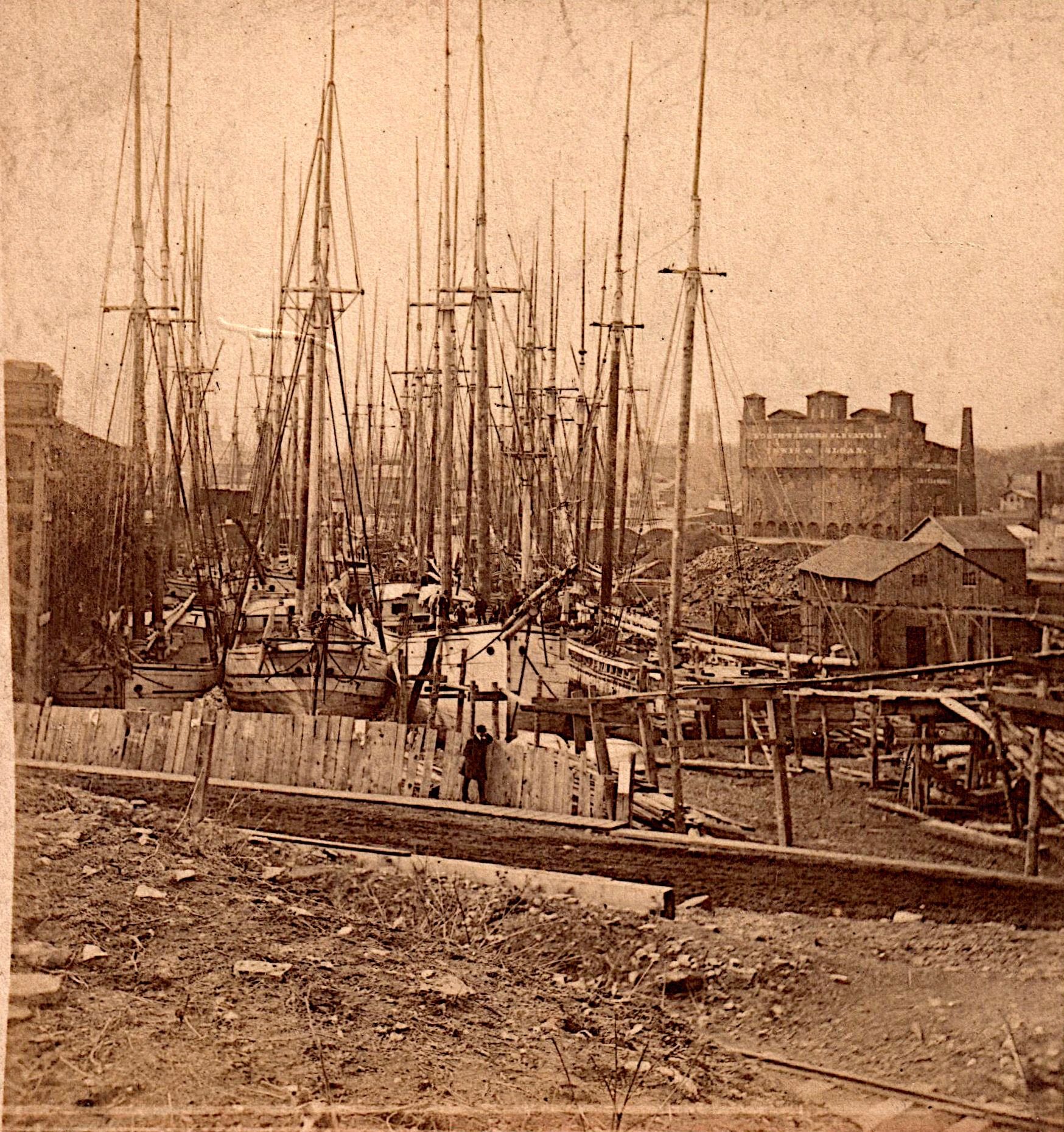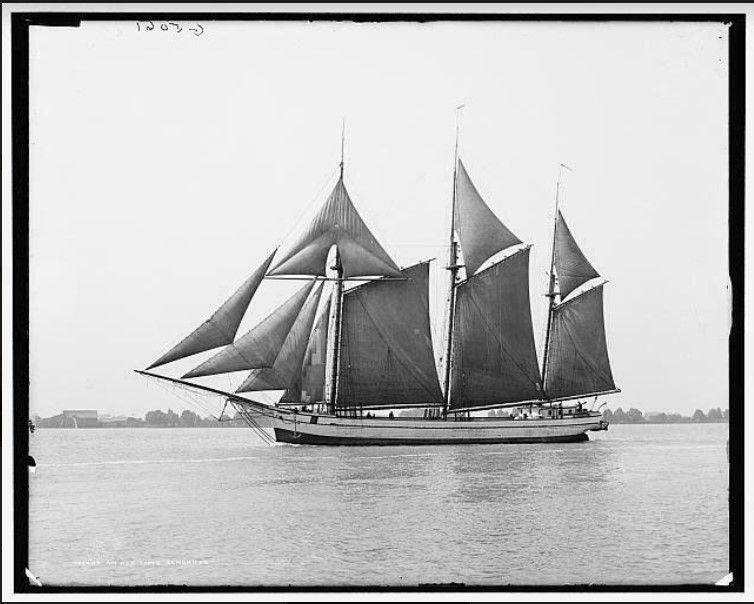In “Spring Fit-Out Part I,” we learned "In the mid-19th century, as many as one hundred ships wintered in such ports as Oswego. As soon as the ice melted, Oswego came alive like a bear awakening from its long winter’s nap. In fact, fitting out is described as a particularly interesting routine to watch, seemingly well-organized down to every detail. The newspapers are suddenly filled with advertisements from the local ship chandleries, grocery, clothing, boot, and shoe stores."
Part II
The manner in which wooden vessels were built and maintained was closely scrutinized for many years by a private regulatory organization known as the International Board of Lake Underwriters, which was made up of such member organizations as the Northwestern Insurance Company of Oswego.
The board occasionally issued what could be called state-of-the-art instruction manuals that set standards for construction, operation, and maintenance of insured vessels. The manuals were written in technical but simple enough jargon that an experienced shipbuilder could understand. It was a fair and honest organization whose rules for construction could be found in practically every reputable shipyard on the Great Lakes.

Since so much time has passed, the actual procedure for fitting out a typical Great Lakes schooner is all but lost. One man still alive in the 1980s, who could recall fitting out, was Carl A. Norberg, later of St. Petersburg, FL. In an interview, he said he went sailing at an early age when there were still a few schooners left on the lakes. He could explain fitting out in great detail. He said in later years, commercial schooners were not maintained as they once were when they were kept in first class condition. He said it was only when autumn storms became impossible to withstand, sailors drowned, and schooners were lost or driven ashore, that owners would grudgingly lay up for the winter in a river or harbor with fair protection.
Sails were removed and stowed. Running rigging was stored in a loft, or below decks. This included the halyards (ropes used to raise and lower the sails). The standing rigging included the ropes, lines, chains, and wires that supported the masts. Sailing vessel crews had an extensive working vocabulary.
Usually one crewman kept watch of the vessel over the winter. But there was a cost – perhaps a dollar a day.
So the winter would pass, with snow and ice accumulating on deck that had to be removed. Finally, the first warm day of spring stirred the owner. Sails were inspected to determine which needed sewing. Newspapers would keep skippers informed of ice conditions on the lakes and rivers.
The Fit-out Begins
It was soon time to prepare for getting under way. A two or three master might need new gear such as throat and peak halyards, sheets for mainsail, spanker, mizzen, foresail, forestaysails, three jibs, plus new lines on topping lifts, which had to be renewed annually. Anchors and chains were inspected one link at a time, using the capstan. Steering gear got close inspection. Norberg said, “We have not mentioned dry rot, and sometimes in fitting out an ice pick or a sharp, long spike of some kind was prodded around on deck, cabin house, hold, and on the topsides for soft wood. If minor, they might let it go. If major, it would be repaired.”
In her last years, a schooner received minimal maintenance. “Owners always hoped for one more season,” Norberg said. “It depended on the insurance rating she had to pass. Grain demanded a sound vessel; lumber, not so necessary.” In later years, old schooners were not painted regularly and appeared very weather-beaten. “Newer boats in the grain, coal, and ore trade were kept up better, some very well. Painting the hull was done from a yawl boat. It was important to properly maintain the running and standing rigging.”
Norberg said properly maintaining the pumps was a must since they owed their survival to them.
Inspecting the hull for leaks might mean dry docking. “Most boats had double planking and some leaks could be stopped from the hold and others from the outside. If planks had to be replaced, haul out was necessary. They might scrub down the bottom and paint it, preferably with anti-fouling caulking."
Norberg said even on the lakes, a growth developed that slowed down a boat. When out of the water, at the stern they could inspect the rudder and up forward, the bobstay (which counteracts the pressure from the forestay). There were two kinds of equipment to cope with these inspections — a permanent or floating dry dock that lifted the boat up by pumping out the water in the dock; or a marine railway where a cradle hauled out the boat as it rolled up the track to a higher level.
Hull caulking could only be done on the bottom when the ship was hauled out. A leaking boat might need the old oakum pulled out with a hook, then replaced with new oakum or cotton, using a caulking tool and mallet. The ringing sound of a mallet and caulking iron is one of the sounds you remember the rest of your life. Caulking was considered an art reserved for skilled craftsmen able to drive it in just so — not too hard, not too soft.
In earlier times, vessels carried horses for loading timber as well as operating the capstan. It was said some of these beasts developed great seaworthiness. When the weather got rough and the ship rolled, the horses would walk up to the weather rigging and grab the ratlines on the shrouds with their teeth and hang on to keep from being knocked down or overboard.
Norberg was especially familiar with the Lucia A. Simpson, one of the last three-masted schooners that operated on the upper Great Lakes; it was after this ship that the replica Denis Sullivan was modelled. She had excellent lines and has also been a favorite of model builders. When built she was considered the epitome of the Great Lakes ship carpenter’s craft. But when Norberg remembered her, it was in her later years. Her glory days had passed and she was poorly maintained, aside from mending the sails and repairing the running rigging. “Down below, she was a filthy hole in the cabin house and forecastle.”
If sailors left any material or tools in the scuppers (lying around on deck) when they were finished working on deck or aloft, it was damn near a criminal offence to the old man (skipper). In really hot weather, there was another daily chore called slushing down. You turned to after breakfast and drew water from over the side and wet down the decks. Some of those ships used a hand operated bilge pump on deck for that purpose. The main reason for those pumps was to keep the water pumped out of the hold if the ship happened to be leaking.

There were many long hard hours of backbreaking work at those pumps in cases of bad leaks and stress of heavy weather. Thus came the old saying among sailors, “What will we do to be saved, skipper?” And the answer was always the same, “Pump, you bastards, pump!”
Any needed items were usually available at the well-stocked ships’ chandlers. There was plenty of work for caulkers in the days of wooden ships and several different kinds of caulking irons were employed. The tucking iron, three ‘making irons,’ and a big ‘horsing iron’ were used on the sides and bottom of the hull. The oakum-filled seams were carefully filled over with pitch, then scraped off clean. In the early days, the dies or outer hull were painted and the decks painted or scrubbed clean with sandstone which the sailors called the ‘holy stone.’
From this came the sailors’ Seven Commandments: “Six days shalt thou labor and do all that thou are able, and on the seventh day you will holy stone the decks and scrape the cables.” According to George Henderson, a bit different were the skippers’ seven commandments . . . the first, second, third, fourth, fifth, sixth, and seventh, “keep her going or she won’t make money.”
George Henderson's Memories
Fitting out was well within the memory of George Henderson, an old sailor from Portsmouth, ON, near Kingston, whose reminiscences are in the collections of the Marine Museum of the Great Lakes at Kingston. The unpublished document is called George Henderson’s Reminiscences.
"My dad often told me that he liked to climb, and he said they were fitting out a sailing vessel at Port Huron or Sarnia, I forget which. However, there were a number of vessels berthed there for the winter and amongst them a big tall three-masted ship from up on the upper lakes. This meant that she was too big to come down through the old Welland Canal.
During the winter months, her signal halliards on the mainmast had got chafed so bad they broke and came down on deck. These halliards were a small rope about three-eighths of an inch in diameter that were used for hoisting a flag or weather sock (commonly known by sailors as a fly) for watching wind direction. Sailors tried to climb or shim up that topmast and reeve off a new halliard and none of them apparently could make it. Now if they couldn’t climb this bare pole or mast and reeve this halliard through the truck or ball on the masthead, it meant that they would have to unrig or let go of the stays, pull the fidd and lower the topmast down to do this job. There was one sailor who knew my dad and he told the skipper of the ship. So the skipper sent for my dad and he said, “They tell me if you can’t climb that stick no one here can.”
So, he said, “If you can go up and reeve off that halliard I will give you five dollars.” That was about a half a month’s pay in those days. So my dad tried it and he got up there all right and rove off the halliard, but he told me afterwards he was sore for days in his legs and arms. He said he never dreamed that a 40-foot stick plus 90 feet up from the deck could be so tall. Well, when he finished the job, the old man paid him the five dollars, and he said he and the rest of his mates went ashore that evening and blew the five. He didn’t tell me how, but years afterwards I could have made a rough guess!”
By Richard F. Palmer
Richard F. Palmer is a retired newspaper editor and reporter, and he was well known for his weekly historical columns for the “Oswego Palladium-Times,” called "On the Waterfront." His first article for TI Life was written in January 2015, and since then, he has written a dozen-plus others. He is a voracious researcher, and TI Life readers benefit from his interests.
Posted in: Volume 18, Issue 5, May 2023, History
Please click here if you are unable to post your comment.
